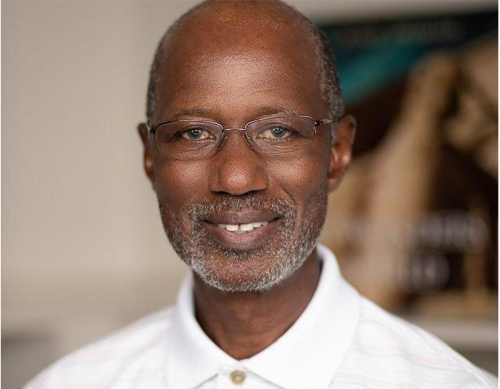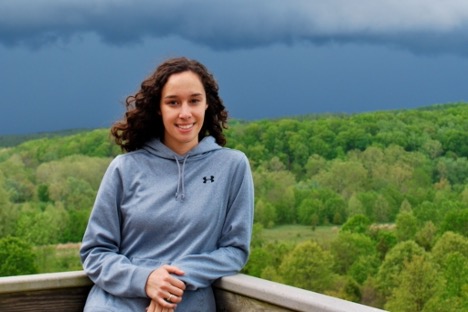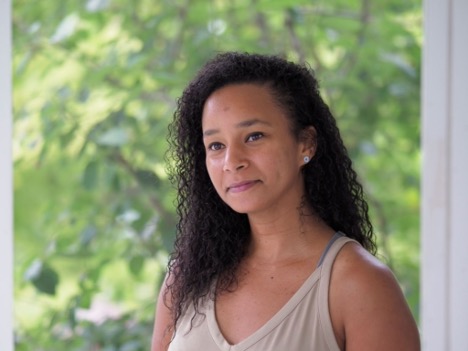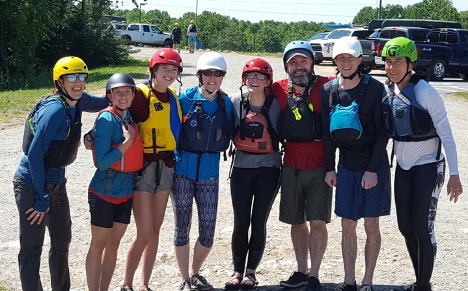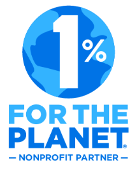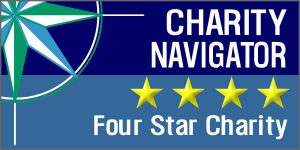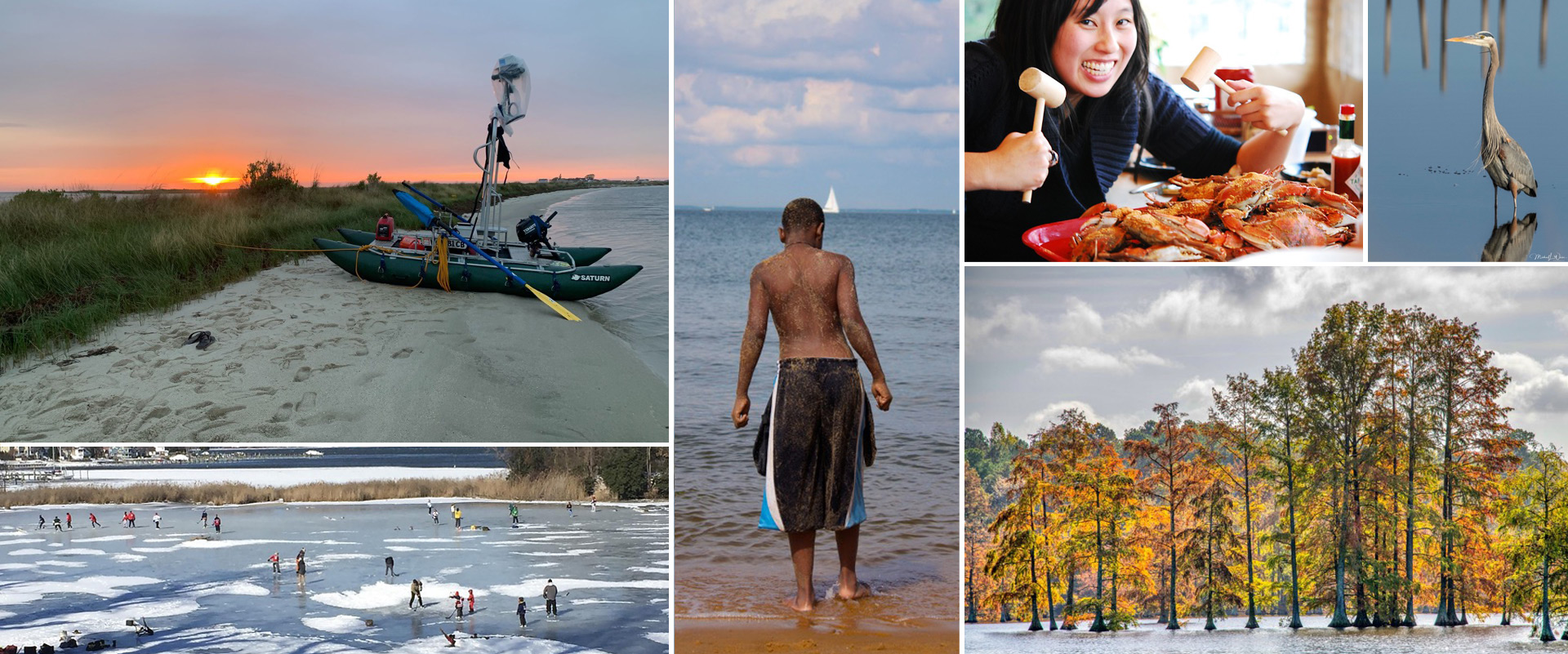Our focus is to conserve and restore the natural and cultural resources of the Chesapeake Bay watershed for the enjoyment, education, and inspiration of this and future generations.
We believe the Chesapeake is a national treasure that should be healthy, accessible to everyone, and its watershed a place where people and wildlife thrive.
To conserve and restore the natural and cultural resources of the Chesapeake Bay watershed for the enjoyment, education and inspiration of this and future generations.
We serve as a catalyst for change, advancing strong public and private partnerships, developing and using new technology and empowering environmental stewardship.
Our objective is to accelerate progress to conserve 30% of the Chesapeake watershed by 2030 by equitably connecting people to the Chesapeake while conserving and restoring priority lands and waters.

Gabrielle Roffe (left), Chesapeake Conservancy manager of equity & community engagement, joined Camilla Sandoval (right), American conservation experience fellow for the National Park Service Tribal, Local, Plans & Grants Division, and Michelle Ramirez (not pictured), multicultural outreach coordinator for Maryland Department of Natural Resources, as presenters at the 2020 Small Museum Association Conference.
Protecting and restoring the Chesapeake Bay requires diversity in perspective and practice.
Chesapeake Conservancy understands that protecting and restoring the natural and cultural resources of the Chesapeake Bay watershed require intentional commitment to inclusive practices and narratives within the conservation movement. Through our work we celebrate and elevate the people, places and cultures of the region, especially by engaging underrepresented communities. Committing to the values of Diversity, Equity, Inclusion and Justice is critical to achieve our vision of a Chesapeake that is healthy, accessible to everyone and a place where people and wildlife thrive. To that end, we commit ourselves to Diversity, Equity, Inclusion and Justice both in our programmatic priorities and our internal organizational development through inclusive recruitment of staff and board members and fostering a diverse and inclusive culture.
- Advocate for and implement the priorities of the Chesapeake Bay Gateways and Watertrails Network and the Captain John Smith Chesapeake National Historic Trail (Chesapeake Trail) in partnership with the National Park Service
- Quantify the conservation movement and empower environmental stewards
- Defend and expand conservation, recreation and restoration programs
- Enhance collaboration and leverage partnerships
- Develop replicable approaches
What We Do
Connect people to the natural, cultural and recreational opportunities of the Chesapeake watershed – including its rivers, tributaries, landscapes and historic places. Implement Captain John Smith Chesapeake National Historic Trail (Chesapeake Trail) and Chesapeake Bay Gateways and Watertrails Network in partnership with the National Park Service.
Work with partners and leverage data-driven strategies to conserve 30% of the Chesapeake watershed’s lands by 2030 and the special places that are important to diverse communities, indigenous tribes, and visitors and that preserve the Chesapeake watershed for this and future generations.
Expedite the Chesapeake watershed restoration effort by leveraging data-driven strategies and partnerships to meet regional habitat and water quality standards and provide their associated community benefits.
Infuse diversity-based policies and practices in our culture that are essential for the success of Chesapeake Conservancy’s mission.
Ensure adequate funding, staff, controls and proficiencies to remain the key partner for connecting, conserving and restoring land and water in the Chesapeake watershed, including with the Earl Conservation Center at Quiet Waters Park.
Message from the Chairman & President
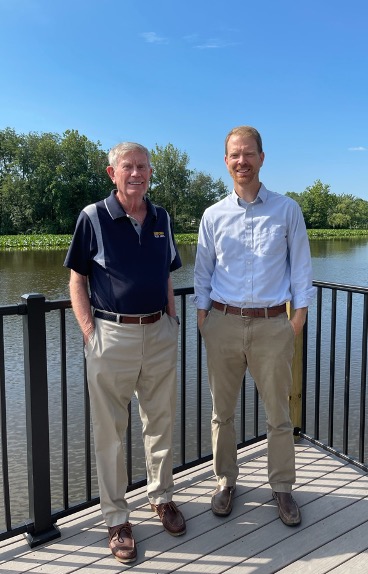
Chesapeake Conservancy Board Chair Randall Larrimore (left) and President and CEO Joel Dunn (right)
Equitably Connecting, Conserving and Restoring the Bay
We are pleased to report that Chesapeake Conservancy managed through the pandemic and accomplished many of our goals. If 2020 taught us anything, it’s that in a seemingly uncertain world, one thing is certain — change is the only constant.
Chesapeake Conservancy board members, staff, partners and supporters like you rose to the challenge and continued to protect clean water, wildlife habitat and our way of life. Like many other organizations, we were confronted by the realities of a global pandemic that demanded we no longer conduct business as usual. Together, we did our best to stay focused on delivering conservation results that will persist long after this storm has passed. And, of course, like many of you, we did this work from home doing our best to help stop the spread of COVID-19.
While the nation looked inward and experienced a social reckoning that was long overdue, as an organization we redoubled our efforts to increase Diversity, Equity, Justice and Inclusion in the conservation movement and throughout our daily work.
As people turned toward nature for solace and recreation during the pandemic, parks throughout the Chesapeake watershed had a hard time meeting demand. People waited in long lines to get into their favorite park, some parks filled early in the day and had to close their gates to new visitors, and many county parks were closed to non-residents. Our hope is that society’s passion and appreciation for outdoor recreation and the environment never fades, but it’s evident that we need more parks—a rally cry shared by conservationists for decades.
In 2020, we joined partners to launch the coalition to create the Chesapeake National Recreation Area (CNRA). It was not by design that we did this during the pandemic and when people were clamoring for more parks, but the pandemic certainly helped explain the need. It’s time for the Chesapeake to have National Park Service status. We thank the growing number of coalition partners and supporters who are helping to advance this worthy effort. Learn more at www.united4cnra.com.
The year brought many significant wins for conservation that will help us meet the goal of conserving 30% of the Chesapeake by 2030. Thanks to your support, Chesapeake Conservancy and our partners across the country worked with Congress to pass the Great American Outdoors Act, one of the biggest conservation victories in decades. This new legislation creates annual funding to protect parks, forests, wildlife refuges and wetlands forever, which will reduce threats to flora and fauna diversity and slow climate change. You also helped us pass the America’s Conservation Enhancement Act, one of the most important bills for the Chesapeake Bay restoration movement in 35 years. Now the National Park Service, U.S. Fish and Wildlife Service and U.S. Environmental Protection Agency can do even more for the Chesapeake.
Thank you for your support during this incredibly difficult year. We have indeed grown stronger together and are optimistic that through our innovative precision conservation, advocacy and strategic partnerships we will dramatically impact the Chesapeake Bay watershed for the benefit of all.

of Directors
Randall W. Larrimore, Chair
Molly Joseph Ward, Vice Chair
Leslie Delagran, Treasurer
Marc Bunting, Secretary
Maite Arce
Mark Belton
Thad Bench
Michael Brubaker
Joel E. Dunn
Verna Harrison
Stephanie Meeks
John G. Neely
Mamie A. Parker, Ph.D.
John J. Reynolds
Chief G. Anne Richardson
Jeffrey Sabot
Richard Scobey
Robert G. Stanton
Nancy B. Walters, Ph.D.
Honorary Members
Gilbert M. Grosvenor
U.S. Senator Paul Sarbanes (ret.)
U.S. Senator John Warner (ret.)
Emeritus Directors
Patrick F. Noonan
Charles A. Stek
David Blitzer
Keith Campbell
Charles H. “Chip” Collins
Dr. Wilton “Wilt” Corkern
Lavinia Currier
Dr. Sylvia Earle
Elinor Farquhar
Sid Jamieson
Amanda Savage Mahoney
Joan Murray
Truman Semans, Sr.
Nancy Merrill Sullivan
Ann Swanson
John Turner
H.W. “Skip” Wieder
Steven Williams
Conservancy Staff
Patty Allen, Vice President of Administration
Jeffrey Allenby, Director of Conservation Technology
Michael Bowman, Partnership Communications Coordinator
Mark Conway, Executive Vice President of Programs
Jody Couser, Senior Vice President of Communications
Jacob Czawlytko, Senior Geospatial Analyst
John Davy, Virginia Project & Partnership Coordinator
Carly Dean, Program Manager
Joel E. Dunn, President & CEO
Melissa Ehrenreich, Senior Vice President of Development & Business Strategy
Jessica Elliott, Chesapeake Conservation Corps Member
Kelsey Everett, Partnership Digital Resources Associate
Ellen Gardner, Senior Vice President of Finance / Chief Financial Officer
Adrienne Gemberling, Project Manager
John Griffin, Program Manager, Chesapeake Conservation Partnership
Louis Keddell, Geospatial Program Manager
Emilie Lahneman, Development & Annual Fund Coordinator
Jacob Leizear, Senior Geospatial Analyst
Kumar Mainali, Geospatial Data Scientist
Joseph McCauley, Chesapeake Fellow
Emily Mills, Geospatial Technology Manager
Susan Minnemeyer, Vice President of Technology
Mary Molloy, Geospatial Analyst
Erin Montgomery, Communications Associate
Mende Naylor, Executive Assistant
Reed Perry, Manager of External Affairs
Matt Provost, Vice President of Development
Sara Ramotnik, Chesapeake Conservation Corps Member
Gabrielle Roffe, Manager, Equity & Community Engagement
David Saavedra, Geospatial Technical Lead
Susan Shingledecker, Vice President & Director of Programs
Helen Sieracki, Human Resources Coordinator
Rachel Soobitsky, Geospatial Project Manager
Lisa Spallitta, Accounting Coordinator
Susan Stephenson, Grants & Contracts Specialist
Katie Walker, Senior Geospatial Analyst/Project Coordinator
Emily Wiggans, Geospatial Analyst
CONSERVATION, RESTORATION AND PUBLIC ACCESS
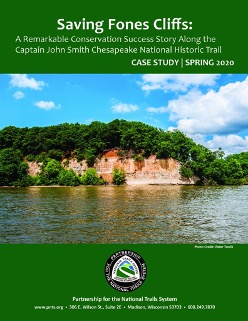
While there is still much work to be done, a portion of Fones Cliffs has been conserved, representing a huge “win” for the Rappahannock Tribe, the Chesapeake Bay, the Rappahannock River Land Protection Partnership, the U.S. Fish and Wildlife Service’s Rappahannock River Valley National Wildlife Refuge, the Commonwealth of Virginia, and the Captain John Smith Chesapeake National Historic Trail. Thank you to the Partnership for the National Trails System and to support from the U.S. Department of Transportation Federal Highway Administration for producing this case study of a conservation success story.
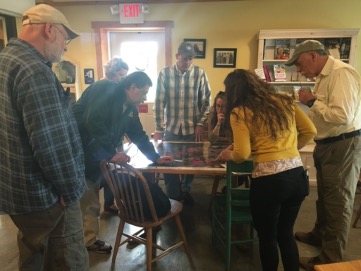
The National Fish and Wildlife Foundation (NFWF) awarded funding to Chesapeake Conservancy and the Precision Conservation Partnership for a major restoration initiative in central Pennsylvania. The funding is provided through the NFWF’s Innovative Nutrient and Sediment Reduction program. Sixteen partners make up the Precision Conservation Partnership and share and transfer knowledge within the region, accelerating community buy-in and restoration engagement through an innovative, hyper-local focused approach.
The three-year project will pair restoration with local partners in six central Pennsylvania counties bringing new funding to the region, resulting in full-farm restoration on 25-30 farms where the greatest benefits to water quality can be realized. This project has the potential to serve as a national model for coordinating on-the-ground implementation with high-resolution mapping to improve the health of streams so they can be removed from Pennsylvania’s impaired streams list — a designation of poor stream quality assigned by the Pennsylvania Department of Environmental Protection.
Chesapeake Conservancy and project partners broke ground in December on a major new public access site on the Nanticoke River in Delaware, phase one of the revitalization of the old J.B. Robinson Oyster House site along the Seaford River Walk. Seaford Mayor David Genshaw and Chesapeake Conservancy Board Chair Randall Larrimore were on hand to mark the occasion.
In June, the Taylors Trail Sand Ridge Ecologically Sensitive Area in Wicomico County became home to an additional 438 acres of conserved land at Blackwater National Wildlife Refuge, thanks to a partnership between the U.S. Fish and Wildlife Service (USFWS), The Nature Conservancy and Chesapeake Conservancy. The Nature Conservancy and the USFWS collaborated to identify the property’s natural attributes and worked with the landowner to add the property to the national refuge system. In addition, Chesapeake Conservancy secured private funds from the Mt. Cuba Center and funds from the sale of the Federal Migratory Bird Hunting and Conservation Stamps, commonly known as Duck Stamps, to finance the acquisition.
In 2020, Chesapeake Conservancy published “Conserving 30% of the Chesapeake Bay Watershed’s Lands by 2030,” a memorandum that outlines our work to implement a 30% by 2030 goal for the Chesapeake landscape. Here in the Chesapeake Bay watershed, where 22% of the Chesapeake’s lands are already protected, this is an achievable goal through hard work, leveraging technology and the power of partnerships — especially the Chesapeake Conservation Partnership.
INNOVATION
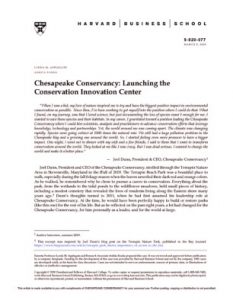 Harvard Business School
Harvard Business School
Studies CIC
In March, Harvard Business School released a case study entitled “Chesapeake Conservancy: Launching the Conservation Innovation Center.” The case will be used in various business and social entrepreneurship courses.
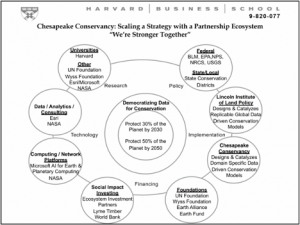 Chesapeake Conservancy and the Lincoln Institute of Land Policy co-hosted the interactive webinar “Earthshot: Democratizing Data to Protect 30% of the Planet by 2030.” The program was facilitated by Dr. Lynda Applegate of Harvard Business School and included opening remarks from Jack Dangermond, founder and president of Esri. Presenters included Clint Brown (Esri), Brian O’Donnell (Campaign for Nature), Dr. Tom Lovejoy (United Nations Foundation), Dr. Lucas Joppa (Microsoft), Jeffrey Allenby (Lincoln Institute of Land Policy) and Joel Dunn (Chesapeake Conservancy).
Chesapeake Conservancy and the Lincoln Institute of Land Policy co-hosted the interactive webinar “Earthshot: Democratizing Data to Protect 30% of the Planet by 2030.” The program was facilitated by Dr. Lynda Applegate of Harvard Business School and included opening remarks from Jack Dangermond, founder and president of Esri. Presenters included Clint Brown (Esri), Brian O’Donnell (Campaign for Nature), Dr. Tom Lovejoy (United Nations Foundation), Dr. Lucas Joppa (Microsoft), Jeffrey Allenby (Lincoln Institute of Land Policy) and Joel Dunn (Chesapeake Conservancy).
 Chesapeake Conservancy’s CIC collaborated with the Colorado Water Conservation Board to highlight work done by the Upper Colorado River Endangered Fish Recovery Program. Funding and support were provided by the Babbitt Center for Land and Water Policy, a center of the Lincoln Institute of Land Policy. “Swimming Upstream” uses data to create an illustrative and interactive digital platform to show the recovery program’s efforts to conserve native and endangered fish populations threatened by invasive species, diverging water uses and needs and other challenges.
Chesapeake Conservancy’s CIC collaborated with the Colorado Water Conservation Board to highlight work done by the Upper Colorado River Endangered Fish Recovery Program. Funding and support were provided by the Babbitt Center for Land and Water Policy, a center of the Lincoln Institute of Land Policy. “Swimming Upstream” uses data to create an illustrative and interactive digital platform to show the recovery program’s efforts to conserve native and endangered fish populations threatened by invasive species, diverging water uses and needs and other challenges.
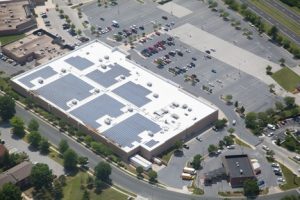 Valleys Planning Council, a nonprofit organization based in Towson, Maryland, commissioned the Chesapeake Conservancy’s CIC to use geospatial analysis to identify optimal solar sites. The October report, Solar Siting Methodology for State and Local Governments Pilot: Baltimore County and City, showed extensive opportunities for placing solar panels on previously degraded lands and on rooftops of commercial, industrial and residential buildings; and by creating solar canopies on parking lots.
Valleys Planning Council, a nonprofit organization based in Towson, Maryland, commissioned the Chesapeake Conservancy’s CIC to use geospatial analysis to identify optimal solar sites. The October report, Solar Siting Methodology for State and Local Governments Pilot: Baltimore County and City, showed extensive opportunities for placing solar panels on previously degraded lands and on rooftops of commercial, industrial and residential buildings; and by creating solar canopies on parking lots.
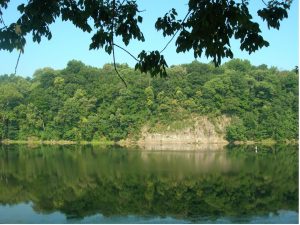 Chesapeake Conservancy’s CIC joined the Safe Water Conservation Collaborative, a vibrant network of more than 25 partners, including water utilities, land conservation organizations and community groups working to protect safe, clean drinking water for communities in the Eastern Panhandle of West Virginia. In June, the collaborative published an interactive map and a story map with support from CIC and the Land Trust Alliance’s Land & Water Initiative to identify land in Jefferson and Berkeley counties essential to drinking water safety.
Chesapeake Conservancy’s CIC joined the Safe Water Conservation Collaborative, a vibrant network of more than 25 partners, including water utilities, land conservation organizations and community groups working to protect safe, clean drinking water for communities in the Eastern Panhandle of West Virginia. In June, the collaborative published an interactive map and a story map with support from CIC and the Land Trust Alliance’s Land & Water Initiative to identify land in Jefferson and Berkeley counties essential to drinking water safety.
Chesapeake Conservancy’s CIC released its findings on park mobility during a period of COVID-19 restrictions. Chesapeake Conservancy’s Geospatial Data Scientist Kumar Mainali and Geospatial Technology Manager Emily Mills used Google’s COVID-19 Mobility Report to detect change in human mobility in parks in the top 25 United States metro areas by population. The July 2020 study found that 8 of 25 metro areas experienced significant increases in park visitation. Within the Chesapeake Bay watershed, Washington, D.C., park visitation was up 93.99% and Baltimore was up 86.97%.
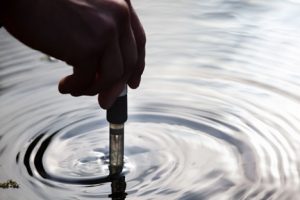 Funded by the Pisces Foundation, Chesapeake Conservancy built a new app for the Water Data Collaborative to help existing water monitoring programs by providing a high-resolution look at the landscape conditions, which can then be compared to observed water quality trends. For groups or individuals that are looking for opportunities for restoration and conservation, this tool can also be used to target the most at-risk areas.
Funded by the Pisces Foundation, Chesapeake Conservancy built a new app for the Water Data Collaborative to help existing water monitoring programs by providing a high-resolution look at the landscape conditions, which can then be compared to observed water quality trends. For groups or individuals that are looking for opportunities for restoration and conservation, this tool can also be used to target the most at-risk areas.
INSPIRING EXPLORATION
CHAMPIONS OF THE CHESAPEAKE
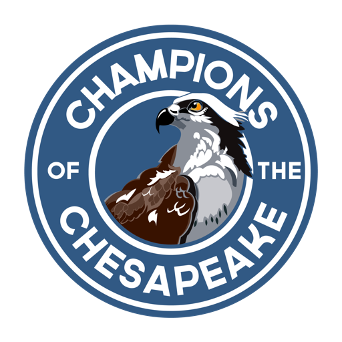
Dennis Chestnut, a native Washingtonian and a lifetime resident of the Hillbrook neighborhood of Ward 7 in Southeast D.C., was awarded the Lifetime Champion award due to his commitment towards restoring the health of the Anacostia River, improving the natural resources located in his community and throughout Washington, and connecting the residents, schools, businesses and civic and community organizations to the area’s many outdoor resources and natural environment.
Anna Killius, a policy analyst at the James River Association (JRA), received the Next Generation award due to her continued stewardship and protection of the James River. Anna has helped to secure bipartisan legislation that keeps coal ash out of rivers and cattle out of streams. She has also successfully advocated for bills that promote the implementation of living shorelines and against bills that would loosen Virginia’s oversight of water use and extraction.
Mariah Davis, policy and campaigns manager at the Choose Clean Water Coalition (CCWC), was awarded the Everyday Hero award. Mariah supports an incredible amount of work on environmental justice initiatives in the watershed. She is an advocate for community voices and authentic engagement with communities. Mariah’s dedication to her work has made and continues to make the Chesapeake Bay watershed’s restoration efforts more equitable, inclusive and just.
Located in Fredericksburg, Virginia, River Rock Outfitter was selected for the Small Business award. River Rock Outfitter is committed not only to the community, but also to protecting water resources along the Rappahannock River. Owner April Peterson has hosted and supported countless events to educate and take action to protect waterways. River Rock Outfitter has sponsored and participated in many litter clean-ups, hosted and sponsored educational movie events, and even developed an annual music festival called “Rock the River” to build public awareness of the importance of protecting the Rappahannock River.
Donors
Our sincere appreciation to the individual, foundation and corporate donors who have made our work possible. We truly appreciate your generosity.
Real Estate
The J Kent McNew Family Foundation
Planned Giving
Mary and Charles Dankmeyer
Richard Scobey
$25,000+
Bunting Family Foundation
James G. Corckran, II
John C. Corckran, Jr.
Matthew Earl and Diane McBee
Farvue Foundation
John G. & Jean R. Gosnell Foundation, Inc.
Mt. Cuba Center
Roemer Foundation
Shared Earth Foundation
The Campbell Foundation
The Helena Foundation
The Merrill Family Foundation
U.S. Endowment for Forestry and Communities
Welfare Foundation
$15,000-$24,999
Bancroft Foundation
Blue Waters Foundation
Forever Maryland Foundation
Patagonia, Inc.
Virginia S. Warner Foundation
$10,000-$14,999
Community Foundation of Anne Arundel County
Mary and Charles Dankmeyer
Randall Larrimore and Cathy Cutright
James M. and Margaret V. Stine Foundation
$1,000-$9,999
Anonymous (3)
Becky Anderson
Curtis Backus
Barbara Bass
Scott Beatty
Mark and Mary Belton
Thad and Renee Bench
Don and Vicky Birch
Ina Bond
Aaron Bowden
Mark and Vicky Collins
Kevin Cooke
Leslie Delagran and Mark McConnell
Bill Dickinson
Arthur Edwards
Elinor Farquhar
Richard L. Franyo
Paul Hagen
Jim and Victoria Handa
Kert Heinecke
Thomas Hunter
Joe and Martha Janney
Jay and Tara Joseph
Judy Larrimore
Lucie Lehmann
Robert Loarie
Laurence Manlove
Mariposa Fund
Joseph McCauley and Julia Herrick
Patrick McGeehin
Stephanie and Rob Meeks
Liza and Sky Morehouse
Barbara Moulton
John and Susan Neely
Origin Creek Energy LLC
Mark and Karen Perreault
Leonard and Anna Pfeiffer
Preservation Maryland
REI
Bill and Donna Roberts
Lynne Rockenbauch
Samuel Rose
Rose Petroleum PLC
Deb and Don Scelza
Steven Schuh
Richard Scobey
Michael Sharp
Evie Sommers
John and Kimberly Thacker
The Bradley and Kathryn Callahan Family Foundation
Edward Tieke
Daniel Tinker
David and Laura Urban
Royall Victor
Virtual Running Club
Wander Project
Molly Ward
Alice and Hill Wellford
WIFIA Team
Great Blue Heron Club ($500-$999)
Anonymous (3)
David Anderson
Gary Anspach
Gray Benoist
Ann Bissell
C. Robert Bunch and Lilia D. Khakimova
Cho-Packer Giving Fund
Duncan and Christina Cocroft
Tom Colberg
Couser Family
Ed and Leslie Cronin
Kent and Meredith Damschroder
Melissa Ehrenreich
Robert and Janellen Frantz
Joseph Gill
Pamela Gregory
Verna Harrison and Bob Pelrine
Barbara Haupt
Page Hayhurst-Kiniry
Jonathan and Laurie Kigner
Kovitz Investment Group
Dale and Patricia Larrimore
Jim Lighthizer
Bruce and Kathy Lowry
Dennis W. Meadowcroft
David and Lisa Mills
Susan Moerschel
Damien Ossi
Mamie Parker
Carmen Perry
Margaret and Reed Perry
Leo Pound
Russ and Beckie Ray
Bill and Wendy Schickler
Nick and Annie Shreiber
Melissa and Peter Smith
Dexter Steis
Charles Stek
Robert and Sally Stobbart
Thomas Straehle
Parvin Titus
Matthew Trotta
David and Maria Vershel
Nancy Walters
David and Evelyn White
Mark Young and Rachel Carren
Eagle Club ($250-$499)
Scott and Kathy Allan
Mary Argleben
Bruce Armistead
Michael Avery
Susan Barnett
Renee Bench
Thad Bench II
Donna Biscieglia
Jim and Shirley Blackwell
Curtis Bohlen
Susan Borschel
Elizabeth Buck
Erica Bulatovic
David Castro
Jim Coffey
Larry Culleen and Nina Weisbroth
Eugene Cunningham
Bob Dane
Janice Davis
Leslie Delagran
Nick Dilks
Jonathan and Dotty Doherty
Sherry Dubester
Mary Clare Duffy
Joel Dunn
Oliver Ehrenreich
Devon and Matthew Ellis
Kathleen Helen Felmey
Paul Ferraro and Kristin Rowles
Whitney Fiore
Betty M. Garrand
Kyle P. German
Jane Gracie
Stacy Graven
John and Michele Griffin
Karl and Maureen Grizio
William Guyton
Ed and Bess Haile
Kimberly Hansen
Colin Harrington
David and Joan Hilgers
Matthew Hunley
Cacky Janssens
Constance Jarowey
Laura Kelm
William and Leslie Lahneman
Joseph Lahr
Rebecca Lawson
Jennifer Lighthizer
Steve and Ann Lindblom
Glennda and David Lockard
Marilyn A. Lockwood
Main Street America Group
Pamela Marks and Michael Mininsohn
Amy Meyer
Mark and Magda Westerhout Mobley
Sally Moulton
Keith O’Connor
Sarah Petit
James Reid and Elizabeth Reid
John and Barbara Reynolds
James and Janet Ross
Kurt and Leslie Schwoppe
John and Lisa Sherwood
Jimmy Slaughter
Doug and Lynn Smarte
Melissa Smith
Daniel Stack
Jim and Amy Stolarski
Edward Strohbehn and Heather Ross
Joan Barton Sundheim
Robin Vaughn
Stafford and Sue Warren
Robert Wheeler
Laura Wiggans
Dale Wilcox
Hsin Hsin Yang
Osprey Club ($100-$249)
Anonymous (9)
Patty Allen
Barbara Anderson
Christine Anderson
Sally Anderson
Rob and Elizabeth Aronson
Lyle Bailey
Elizabeth Barrett
Maureen Barrett
Susan Barron
Mai-Liis Bartling
Chris Baugher
Tim and Kathy Berghoff
Jason and Caryn Berstein
Gordon Binder and Michael Rawson
Cheryl Bishop
Carl Robert Brooks
David Brown and Anna Williams
Sandy Brown
Warren Brown
Jane Buch
Peter Bungay
Patricia Bursaw
Rebecca Byrd
Anna Capetanakis
Bob and Jona Capra
J. David and Anna Castle
William Cobb
Walter and Suzanne Cochran-Bond
Alicia Cramer
Mary Ann Cronin
Joshua Daskin
Gary Davis
Gary Deems
Paula A. Degen
D. Cameron DeHeer
Carla Dinowitz
Michele Doyel
Jeffrey Drill
Barbara Earley
Ben Ehrenreich
Susan Ehrenreich
Steve Elkinton
Dorry Emmer
Janet Evans
Michael Fach
Amanda Field
James Fortune
Samantha Gagnon
Sarah Gallen
Gerald Gallwas
Garden Club of Twenty, Inc.
Ellen Gardner
Linda Gaydos
David and Rebecca Genshaw
Carolyn Goddard
Cynthia Wagner Golliday
Bill Gourgey
Sari Graven
Jay Gronlund
Julie Hamiton
Chris and Meg Hankin
Garrett Hansen
Melinda and Terry Harris
Virginia Bice Hartman
Christine Hayes
Matthew Heil
Donald Hellmann
William Hendrickson
Terry Hickey
Stephen Higgins
Gregory Holobaugh
Mary Holthaus
Richard Hook
Carolyn and David Houck
Carol Husband
Sallie Jackson
James Jackson
Destry Jarvis
Janice John
Elizabeth G. Johnson
Melissa Johnston
Patricia Jonas
Mary Kelly
Phyllis Kilby
Betsy Kirkpatrick-Howat
John Knud-Hansen
Greg Koeln
Rangan Krishnamurthy
Steve Lafferty
William and Margaret Lahneman
Ruby S. Lehman
Gilbert Leidig
Christina Leijonhufvud
Karen Liese
John Light
Fred and Jean Lucas
Adele Madden
Michelle and Ken Madden
Kumar Mainali
Brian and Janalee Malikian
Joseph and Anne Maroon
Larry Matney
Michael and Phyllis McCauley
Elizabeth McCormick
Ben McDearmon and Julie Burns
Peter McGarvey
Robert McIntosh
Richard Mendenhall
Dean Merritt
Cyndy Carrington Miller
Mara Miller
Emily Mills and Danny Berghoff
Alan Mintz
Alison Moore
Kathy Morgan
Susan Morrill
David and Kimberly Morrow
Robert Newry
Jeff and Linda Norris
Mary Margaret Nousek
Lloyd E Oliver
Kent and Phoebe Palcanis
Cassandra Pallai
Steve and Polly Percy
Terry Pinkston
Alison Pitts
Ann Powers
Matthew Provost
Wesse Ranes
Joshua Rawitch
Judith M. Rhodes
Peter Rice
David Riherd and Nancy Betts
Craig and Joyce Riley
Brant Ringler
Charles and Patricia Robertson
Ruth Robinson
Letitia Robson
Barbara Rooney
Alan Saavedra
Douglas Sanford
Ellen Schall
Jay and Camilla Schwarz
Elaine Selby
Bob and Leah Shepherd
Robert Shields
Luke and Susan Shingledecker
Ben Shneiderman
Tom Shock
Richard Shrum
Simon Sidamon-Eristoff
Robert Smythe
Lisa Spallitta
Rick and Jill Springer
Michael Stack
Jacqueline E. Stephenson
Lacey Stevens
Patrick Sullivan
Diana Sullivan
Ann and Eric Swanson
Linda Tatro
Lucius Taylor
Lynda Taylor
Bill and Linda Teare
The Carter-Minnemeyer Family
The Garay Family
The Godstrey Family
Lawrence Thompson
Daveyne Totten
Ted and Jeanne Trott
Craig Turner
Katherine Tyra
United Way of Delaware
Linda Valle
Amy Vaughn
Louise Wagner
Robert Waldman
Russell and Penny Wallace
Susan Wallace
Bill Walters
Diana Weatherby
Helene Weil
Jay Weitzel
Richard Welch
Harrison and Sue Wellford
John Wethern
Patty Widerman
Derek Wilkinson
Linda Williams
Sharee Williamson
Dave Wilson
Michael and Joyce Wilson
Linda Wright
David Wye
David Yang
Uri Yokel
Donna and Bob Zellers
Chesapeake Stewards Club
(Monthly Donors)
Barbara Anderson
Morgan Bench
Verna Harrison and Bob Pelrine
Christine Hayes
Matthew Heil
Matthew Hunley
Joe and Martha Janney
Lucie Lehmann
Michael and Phyllis McCauley
Reed Perry
Melissa and Peter Smith
Thomas Straehle
In-Kind Gifts
Benchworks
Beveridge & Diamond
Keith Chapman
explore.org
Hogan Lovells
Mahan Rykiel Associates
Matching Gifts
Baird Foundation, Inc.
IBM Corporation
Main Street America Group
Patagonia, Inc.
The Boston Consulting Group, Inc
Union Privilege
Donation Honorees
Sam Anawalt
Nancy and Dave Balliet
Susan Blumenstock
Boh 2 and Barb Baltimore Falcons
Bonnie and Peter
Chesapeake Conservancy and Its Employees
Joel Dunn
Melissa Ehrenreich
Jamie Harms
Lawrence O. Hickey
Tim and Anne Hunt
Doug Krause
Jerry Kustich and Sharon Mutch
William and Leslie Lahneman
Randy Larrimore
Alberta E Leirzel
Chrysa Long and Jim Riordan
Marvel, our loyal companion
Johanna McCrehan
Chris O’Connor
Steve and Anne Parr 50th Wedding Anniversary
Kim Pins and Bill Moeller
Warrie and Jim Price
Sullivan and Shiloh Provost
John Reynolds
Sarah Sanford
Susan Shingledecker
The Ellis Family
The Gagnon Family
The Gorinsons
The Hunleys
The Parr Carr Family
The Plotts
The Skeens
Richard B. Thompson
Will, Catherine and Bennett Wallace
Sen. John W. Warner
In Memoriam Honorees
Frances Smith Armstrong
Frank Brooks
Charlie Lee Byrd
William Carleton
Judith Cassello
James Mooar Clifford, Jr.
Catherine Lynn Creech
Christopher Jeffers Forzano
Albert Frankel
Carol Hamilton
Michael Hethmon
Bernard Jonas
Allan Kover
John Maounis
Patrick McCauley
Peggy McCrystal
Thelma I. W. Moerschel
Harold G and Frances R Moulton
Nancy R. Oliver
David Owen, Sr.
Jim Patten
Daniel C. Roper, IV
Roy Ruth
David Selby
The two blue heron babies that perished
Sharon Thomas
Preston Long Tkacz
Alice and Ray Von Saunder
Tom Williams
Wynne Williams
Partners and Clients
Alliance for the Chesapeake Bay
Appalachian Trail Conservancy
Center for Watershed Protection, Inc.
Chesapeake Bay Foundation-Pennsylvania
Chesapeake Bay Trust
Conservation Foundation of Lancaster County
Ecosystem Investment Partners
Harford Land Trust
Hillsdale Fund
James River Association
Land Trust Alliance
Lincoln Institute of Land Policy
Lower Shore Land Trust
Maryland Department of Natural Resources
Northern Virginia Conservation Trust
Scenic Rivers Land Trust
The Conservation Fund
Valleys Planning Council
Virginia Environmental Endowment
Western Pennsylvania Conservancy
Wildlife Management Institute


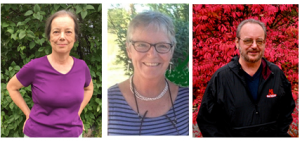 “We are working with the Chesapeake Conservancy to permanently protect our 82-acre family farm in Jefferson County, West Virginia. The property will soon be converted into a new park for the Jefferson County Parks & Recreation system and will increase outdoor recreation, public access and education while simultaneously protecting our watershed and native species. We deeply appreciate the extensive knowledge, skills and experience the Conservancy brings to protecting the entire Chesapeake Bay watershed and are very grateful for their support and guidance.”
“We are working with the Chesapeake Conservancy to permanently protect our 82-acre family farm in Jefferson County, West Virginia. The property will soon be converted into a new park for the Jefferson County Parks & Recreation system and will increase outdoor recreation, public access and education while simultaneously protecting our watershed and native species. We deeply appreciate the extensive knowledge, skills and experience the Conservancy brings to protecting the entire Chesapeake Bay watershed and are very grateful for their support and guidance.”
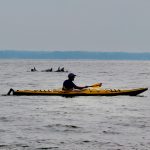 “The Gosnell Foundation is honored to support the Chesapeake Conservancy's efforts to create a Chesapeake National Recreation Area, to create a united place and framework to engage the public in its ecosystem and cultures.”
“The Gosnell Foundation is honored to support the Chesapeake Conservancy's efforts to create a Chesapeake National Recreation Area, to create a united place and framework to engage the public in its ecosystem and cultures.”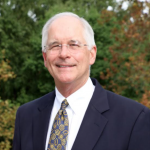 ”The Grayce B. Kerr Fund, Inc. invested in new science capacity at the Conservancy to unlock data breakthroughs for conservation. Pioneering new AI approaches, Chesapeake Conservancy has shown how management quality data can be produced with the touch of a button that will change how landscapes are conserved everywhere.”
”The Grayce B. Kerr Fund, Inc. invested in new science capacity at the Conservancy to unlock data breakthroughs for conservation. Pioneering new AI approaches, Chesapeake Conservancy has shown how management quality data can be produced with the touch of a button that will change how landscapes are conserved everywhere.”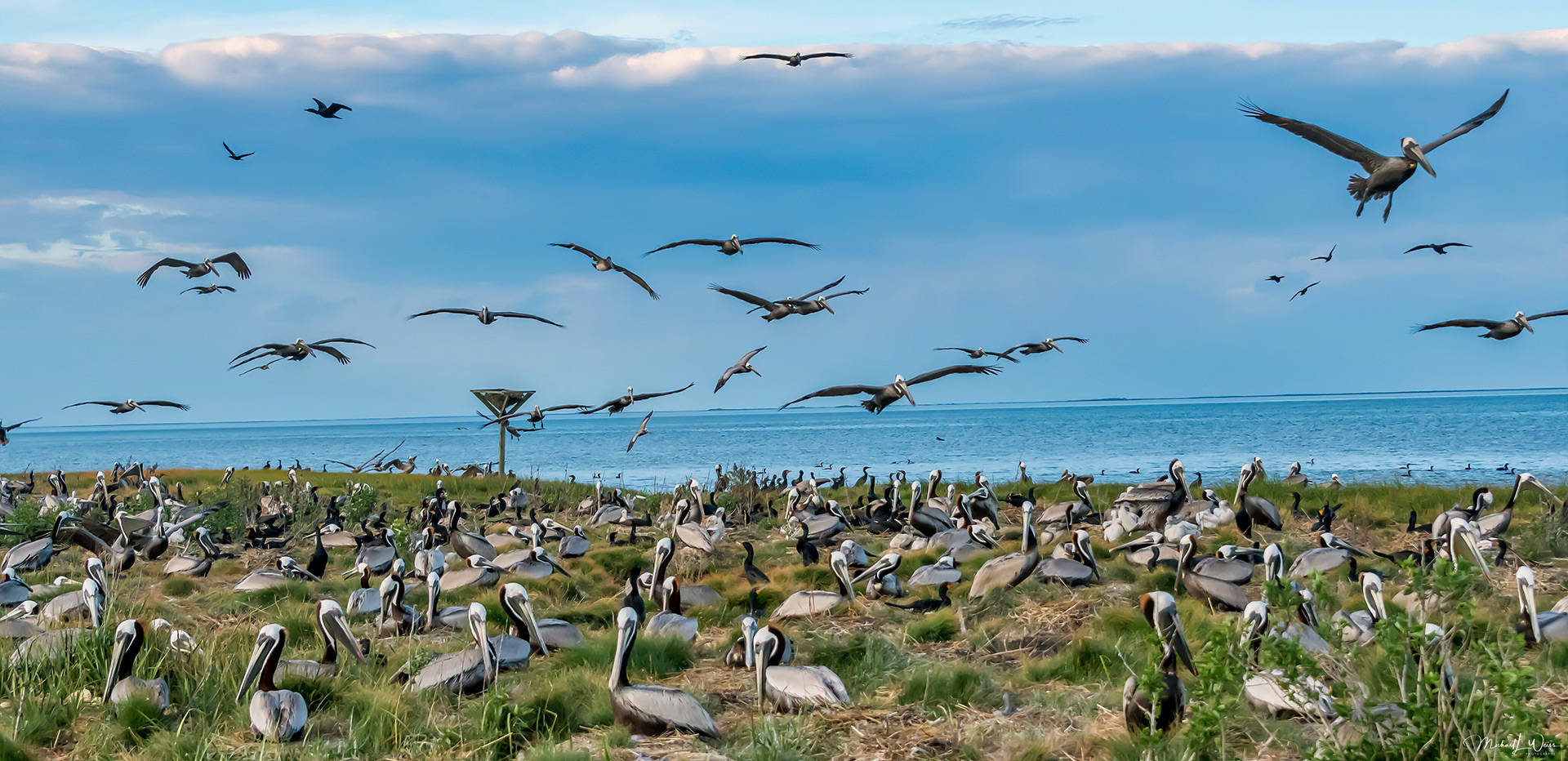
 More than 18 million people call the Chesapeake home and have fallen in love with its awesome landscapes and rivers. So much so that thousands of acres of open space disappear each year. We are in a race against time to conserve, protect and restore what makes the Chesapeake so special before it is too late. Thank you for supporting our work. No amount is too small or too large to help us achieve great things together.
More than 18 million people call the Chesapeake home and have fallen in love with its awesome landscapes and rivers. So much so that thousands of acres of open space disappear each year. We are in a race against time to conserve, protect and restore what makes the Chesapeake so special before it is too late. Thank you for supporting our work. No amount is too small or too large to help us achieve great things together.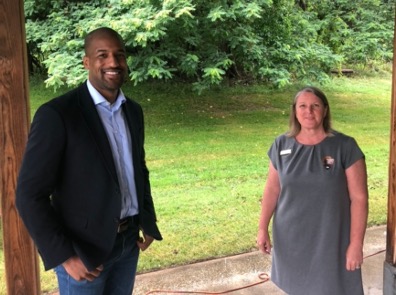
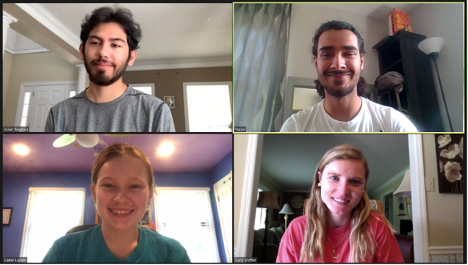

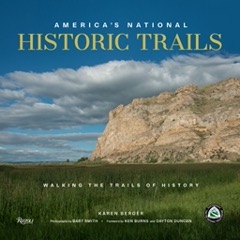 Chesapeake Conservancy is a proud partner and advocate for the Chesapeake Trail, a 3,000-mile water and land trail that highlights the landscapes of the American Indians who lived in the Chesapeake region, the voyages of Captain John Smith and his crew from 1607–1609 and the natural resources of the Chesapeake Bay and its tributaries. Since its founding in 2006, we have assisted in increasing public access and protecting the land along the trail.
Chesapeake Conservancy is a proud partner and advocate for the Chesapeake Trail, a 3,000-mile water and land trail that highlights the landscapes of the American Indians who lived in the Chesapeake region, the voyages of Captain John Smith and his crew from 1607–1609 and the natural resources of the Chesapeake Bay and its tributaries. Since its founding in 2006, we have assisted in increasing public access and protecting the land along the trail.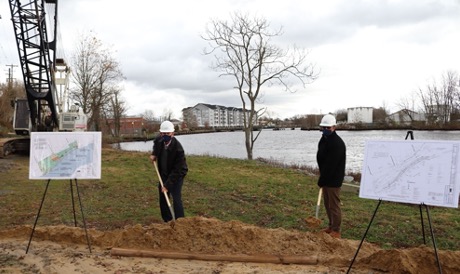
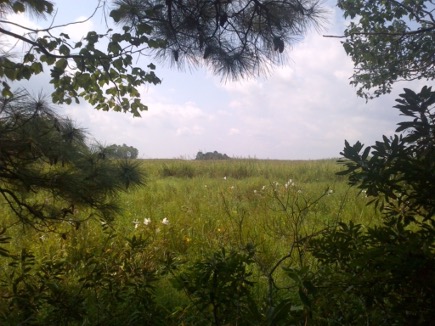
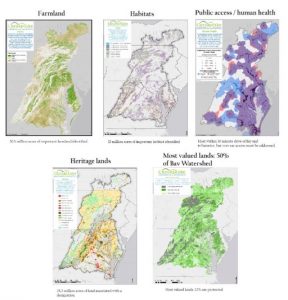
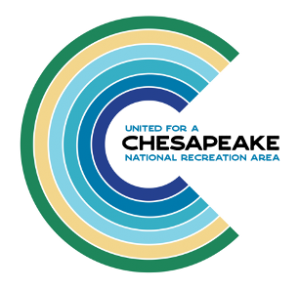 Chesapeake National Recreation Area (CNRA)
Chesapeake National Recreation Area (CNRA)
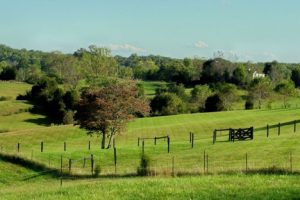 Chesapeake Conservancy celebrated Virginia Governor Ralph Northam’s ConserveVirginia 2.0 Plan. This June update added important geospatial data to the cutting-edge, original ConserveVirginia Plan, especially the new water quality layer and enhancements to the existing scenic and cultural layers.
Chesapeake Conservancy celebrated Virginia Governor Ralph Northam’s ConserveVirginia 2.0 Plan. This June update added important geospatial data to the cutting-edge, original ConserveVirginia Plan, especially the new water quality layer and enhancements to the existing scenic and cultural layers.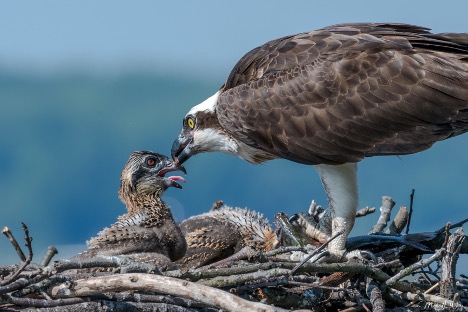
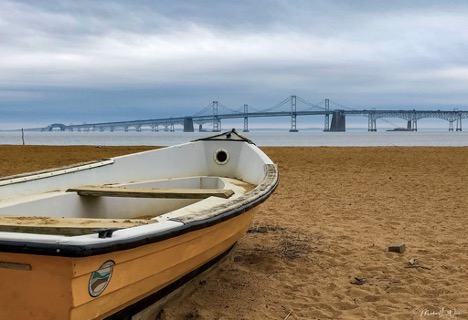
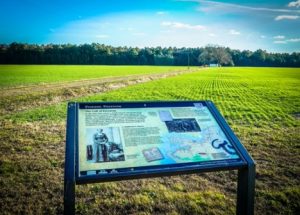
 Chesapeake Conservancy celebrated successful advocacy for conservation outcomes in the omnibus appropriations bill for Fiscal Year (FY) 2021. The bill increased funding for the Chesapeake Bay Program by $2.5 million and fully funded the National Park Service’s Chesapeake Bay Gateways and Watertrails Network program at $3 million.
Chesapeake Conservancy celebrated successful advocacy for conservation outcomes in the omnibus appropriations bill for Fiscal Year (FY) 2021. The bill increased funding for the Chesapeake Bay Program by $2.5 million and fully funded the National Park Service’s Chesapeake Bay Gateways and Watertrails Network program at $3 million.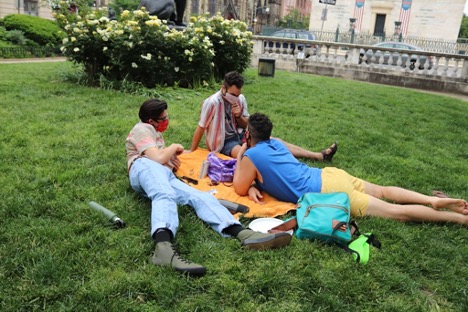

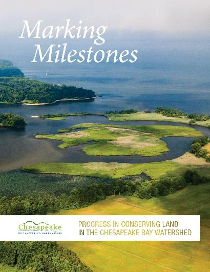
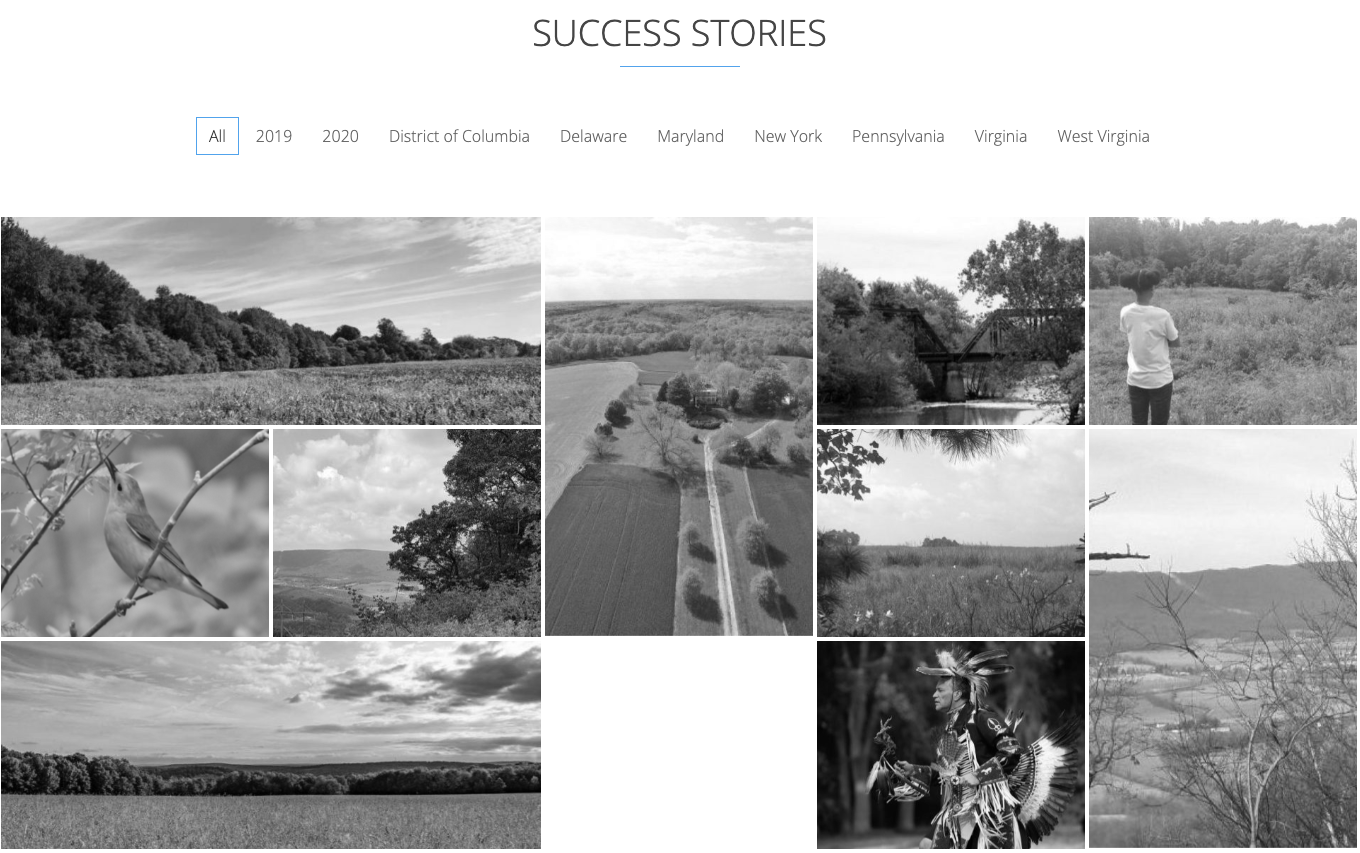 2020 Success Stories
2020 Success Stories




